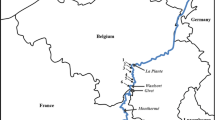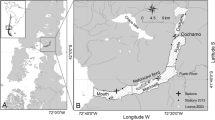Abstract
Mussel bed community structure of two intertidal mytilids, Septifer virgatus (Wiegmann) and Hormomya mutabilis (Gould), whose beds were contiguous vertically on a rocky intertidal shore (Wakayama Prefecture, Japan), was compared between 1982 and 1983. In the upper S. virgatus bed, crustaceans and bivalves were dominant in terms of both number of individuals and biomass. There were three barnacle species representative of the epizoans, two isopods and one amphipod as mobile fauna, and two bivalves as infauna. The lower H. mutabilis bed supported virtually no epizoans or mobile fauna. Infaunal free-ranging polychaetes and sipunculids were dominant in terms of both number of individuals and biomass. The H. mutabilis bed contained a much greater amount of sediment than did the S. virgatus bed, and the interstices among individual H. mutabilis and among their byssal threads were filled with sediment. The biomass of six of nine species dominant in the S. virgatus bed was negatively correlated with the amount of sediment. Recruitment of these faunal assemblages into artificial mussel clumps was examined in mussel enclosure experiments, and a negative sediment effect in H. mutabilis clumps was detected for one isopod and one limpet species. Factors causing the differences between two mussel bed communities are discussed, focusing on the effects of sediment.
Similar content being viewed by others
References
Asmus H (1987) Secondary production of an intertidal mussel bed community related to its storage and turnover compartments. Mar Ecol Prog Ser 39:251–266
Barkai A, Branch GM (1988) Contrasts between the benthic communities of subtidal hard substrata at Marcus and Malgas Islands: a case of alternative stable states? S Afr J mar Sci 7:117–137
Bertness M D (1984) Ribbed mussels and Spartina alterniflora production in a New England salt marsh. Ecology 65:1794–1807
Branch GM, Barkai A (1988) Interspecific behaviour and its reciprocal interaction with evolution, population dynamics and community structure. In: Chelazzi G, Vannini M (eds) Behavioral adaptation to intertidal life. Plenum Press, New York, pp 225–254
Commito JA (1987) Adult-larval interactions: predictions, mussels and cocoons. Estuar cstl Shelf Sci 25:599–606
Commito JA, Boncavage EM (1989) Suspension-feeders and coexisting infauna: an enhancement counterexample. J exp mar Biol Ecol 125:33–42
Dittman D, Robles C (1991) Effect of algal epiphytes on the mussel, Mytilus californianus. Ecology 72:286–296
Griffiths CL, Hockey PAR, Van Erkom Schurink C, Le Roux PJ (1992) Marine invasive aliens on South African shores: implications for community structure and trophic functioning. S Afr J mar Sci 12:713–722
Hiwatari T, Kajihara T (1984) Population dynamics and life cycle of Hyale barbicornis (Amphipoda, Crustacea) in a blue mussel zone. Mar Ecol Prog Ser 20:177–183
Iwasaki K (1992) Factors affecting interindividual variability in resting site fidelity in the limpet, Cellana toreuma (Reeve). Ecol Res 7:305–331
Iwasaki K (1993) Analyses of limpet defence and predator offence in the field. Mar Biol 116:277–289
Iwasaki K (1994a) Distribution and bed structure of the two intertidal mussels Septifer virgatus (Wiegmann) and Hormomya mutabilis (Gould). Publs Seto mar biol Lab 36:223–247
Iwasaki K (1994b) Intra- and interspecific variation in activity patterns of intertidal limpets. Venus (Jap J Malacol) 53:85–104
Iwasaki K (1995) Factors delimiting the boundary between vertically contiguous mussel beds of Septifer virgatus (Wiegmann) and Hormomya mutabilis (Gould) Ecol Res (in press)
Jacobi CM (1987) Spatial and temporal distribution of amphipoda associated with mussel beds from the Bay of Santos (Brazil). Mar Ecol Prog Ser 35:51–58
Johnson WS (1976) Biology and population dynamics of the intertidal isopod Cirolana harfordi. Mar Biol 36:343–350
Kautsky N, Evans S (1987) Role of biodeposition by Mytilus edulis in the circulation of matter and nutrients in a Baltic coastal ecosystem. Mar Ecol Prog Ser 38:201–212
Kimoto S (1967) Some quantitative analysis on the Chrysomelid fauna of the Ryukyu Archipelago. Esakia 6:27–54
Knight-Jones EW, Crisp DJ (1953) Gregariousness in barnacles in relation to the fouling of ships and to antifouling research. Nature, Lond 171:1109
Lintas C, Seed R (1994) Spatial variation in the fauna associated with Mytilus edulis on a wave-exposed rocky shore. J mollusc Stud 60:165–174
Mattsson J, Linden O (1983) Benthic macrofauna succession under mussels, Mytilus edulis L. (Bivalvia), cultured on hanging longline. Sarsia 68:97–102
Newell RC (1979) Biology of intertidal animals. Marine Ecological Surveys Ltd., Faversham
Ohsako Y, Iwasaki K, Sakimukai S, Fukutomi T, Satake K (1981) An example of the distribution of organisms in intertidal zone near the Seto Marine Biological Laboratory of Kyoto University. I. Nankiseibutsu 23:97–102 (in Japanese)
Ohsako Y, Iwasaki K, Sakimukai S, Fukutomi T, Satake K (1982a) An example of the distribution of organisms in intertidal zone near the Seto Marine Biological Laboratory of Kyoto University. II. Nankiseibutsu 24:47–52 (in Japanese)
Ohsako Y, Iwasaki K, Sakimukai S, Fukutomi T, Satake K (1982b) An example of the distribution of organisms in intertidal zone near the Seto Marine Biological Laboratory of Kyoto University. III. Nankiseibutsu 24:107–113 (in Japanese)
Ong Che RG, Morton B (1992) Structure and seasonal variations in abundance of the macro-invertebrate community associated with Septifer virgatus (Bivalvia: Mytilidae) at Cape D'aguilar, Hong Kong. Asian mar Biol 9:217–233
Paine RT (1974) Intertidal community structure: experimental studies on the relationship between a dominant competitor and principal predator. Oecologia 15:93–120
Paine RT, Levin SA (1981) Intertidal landscapes: disturbance and the dynamics of pattern. Ecol Monogr 51:145–178
Pielou EC (1966) Species-diversity and pattern-diversity in the study of ecological succession. J theor Biol 10:370–383
Seed R, Suchanek TH (1992) Population and community ecology of Mytilus. In: Gosling E (ed) The mussel Mytilus: ecology, physiology, genetics and culture. Elsevier, Amsterdam, pp 87–169
Suchanek TH (1980) Diversity in natural and artificial mussel bed communities of Mytilus californianus. Am Zool 20:807
Suchanek TH (1985) Mussels and their role in structuring rocky shore communities. In: Moore PG, Seed R (eds) The ecology of rocky coasts. Hodder and Stoughton, London, pp 70–96
Tokeshi M, Romero L, Tarazona J (1989) Spatial coexistence of mussel-associated free-ranging polychaetes in a subtropical intertidal habitat. J Anim Ecol 58:681–692
Tsuchiya M (1979) Quantitative survey of intertidal organisms on rocky shores in Mutsu Bay, with special reference to the influence of wave action. Bull mar biol Stn Asamushi 16:69–86
Tsuchiya M (1980) Biodeposit production by the mussel Mytilus edulis L. on rocky shores. J exp mar Biol Ecol 47:203–222
Tsuchiya M (1982) Catching of organic matter by the mussel Mytilus edulis L. on rocky shores. Bull mar biol Stn Asamushi 17:99–107
Tsuchiya M, Nishihira M (1985) Islands of Mytilus as a habitat for small intertidal animals: effect of island size on community structure. Mar Ecol Prog Ser 25:71–81
Tsuchiya M, Nishihira M (1986) Islands of Mytilus as a habitat for small intertidal animals: effect of Mytilus age structure on the species composition of the associated fauna and community organization. Mar Ecol Prog Ser 31:171–178
Valentine JF, Heck Jr KL (1993) Mussels in seagrass meadows: their influence on macroinvertebrate abundance and secondary production in the northern Gulf of Mexico. Mar Ecol Prog Ser 96: 63–74
Witman JD (1987) Subtidal coexistence: storms, grazing, mutualism, and the zonation of kelps and mussels. Ecol Monogr 57:167–187
Author information
Authors and Affiliations
Additional information
Communicated by T. Ikeda, Hiroshima
Rights and permissions
About this article
Cite this article
Iwasaki, K. Comparison of mussel bed community between two intertidal mytilids Septifier virgatus and Hormomya mutabilis . Marine Biology 123, 109–119 (1995). https://doi.org/10.1007/BF00350329
Received:
Accepted:
Issue Date:
DOI: https://doi.org/10.1007/BF00350329




